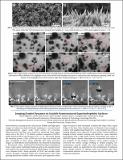Jumping Droplet Dynamics on Scalable Nanostructured Superhydrophobic Surfaces
Author(s)
Miljkovic, Nenad; Preston, Daniel John; Enright, Ryan; Adera, Solomon E.; Nam, Youngsuk; Wang, Evelyn N.; ... Show more Show less
DownloadMain article, figures, and supplementary information (856.7Kb)
OPEN_ACCESS_POLICY
Open Access Policy
Creative Commons Attribution-Noncommercial-Share Alike
Terms of use
Metadata
Show full item recordAbstract
Environmental scanning electron microscope (ESEM) and high speed images of coalescence-induced droplet jumping on a nanostructured superhydrophobic copper oxide (CuO) surface are presented. Nanostructured CuO films were formed by immersing clean copper sheets into a hot (96 ± 3 °C) alkaline solution composed of NaClO2, NaOH, Na3PO4•12H2O, and DI water (3.75 : 5 : 10 : 100 wt.%). During the oxidation process, a thin (<200 nm) Cu2O layer was formed that then re-oxidized to form sharp, knife-like CuO oxide structures (Figure 1). Hydrophobic functionalization was obtained by depositing a fluorinated silane (trichloro(1H,1H,2H,2H-perfluorooctyl)silane) from a vapor phase. Individual droplet growth on the nanostructured CuO surfaces was characterized using an ESEM (Figure 2). The images were obtained with a beam potential of 20 kV and variable probe current. Droplets nucleated within the nanostructures and, while growing beyond the confines of the structures, their apparent contact angle increased as they developed a balloon-like shape with a liquid bridge at the base. Once droplets grew to diameters large enough to coalesce with neighboring droplets (R ≈ 7 μm), frequent out-of-plane jumping droplets were observed. To gain further understanding on jumping velocity, droplet jumping was studied in a pure saturated environment with a high speed camera. Recordings were taken at 2000 FPS. Figure 3 shows a time lapse of a coalescence event between two droplets. As the droplets coalesce, excess surface energy is converted into kinetic energy resulting in droplet jumping. The visualizations provide insight into these complex droplet-surface interactions, which are important for the development of enhanced phase change surfaces. In addition, these CuO surfaces offer ideal condensation behavior in terms of emergent droplet morphology and coalescence dynamics.
Date issued
2013-07Department
Massachusetts Institute of Technology. Department of Mechanical Engineering; Massachusetts Institute of Technology. Device Research LaboratoryJournal
Journal of Heat Transfer
Publisher
American Society of Mechanical Engineers
Citation
Nenad, Miljkovic, Daniel John Preston, Ryan Enright, Solomon Adera, Youngsuk Nam, and Evelyn N. Wang. “Jumping Droplet Dynamics on Scalable Nanostructured Superhydrophobic Surfaces.” Journal of Heat Transfer 135, no. 8 (August 1, 2013): 080907.
Version: Author's final manuscript
ISSN
0022-1481
1528-8943